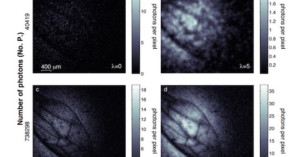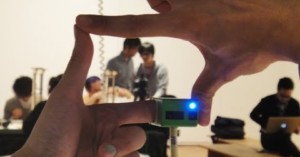
Camera Plunges Down 300ft Antarctic Hole to Find Earth’s Oldest Ice
A team of scientists sent a camera down a 300-foot (93 meters) borehole so it can reveal the oldest ice on Earth.

A team of scientists sent a camera down a 300-foot (93 meters) borehole so it can reveal the oldest ice on Earth.

Canon has partnered with an Australian university to bundle 10 Canon EF 400mm f/2.8 L IS II lenses together into what they call the Huntsman Telescope to scout the skies from the Southern Hemisphere.

Recent developments in artificial intelligence (AI) allow 3D scenes to be generated from just a handful of photos, but Waymo researchers pushed the idea to the extremes and have successfully recreated a 3D model of San Francisco from 2.8 million input photos.

Researchers from the Technion – Israel Institute of Technology have developed a method of manufacturing optical components faster and cheaper for a variety of purposes, which could include camera optics.

An international team of researchers has bundled groups of 24 Canon EF 400mm f/2.8 lenses together into what they call the Dragonfly Telephoto Array in order to capture photos of distant stars.

An international team of scientists has developed an experimental camera system that can simultaneously capture five dimensions of information from a single snapshot. The concept works by combining two types of sensors together to gather a wealth of information all at the same time.

A team of researchers has put together a new initiative with an available open-source code to help better detect deepfakes that have been edited to remove watermarks with the goal of avoiding the spread of misinformation.

A group of international robotics researchers has developed an urban search and rescue solution that skirts past the current limitations of miniature robotics through what they are calling an insect computer hybrid system, which fuses a living insect platform with a microcontroller.

A research paper released by the University of Chicago Crime Lab and the Council on Criminal Justice's Taskforce on Policing shows that body-worn cameras are both "beneficial and cost-effective."

A group of researchers from EPFL's Audiovisual Communications Laboratory had a unique opportunity to investigate some of the very first color photographs ever made, which were originally produced by scientist and inventor Gabriel Lippmann.

Multiple companies including Microsoft and Facebook as well as researchers from The University of Southern California have developed technologies to combat deepfakes and prevent their spread of false media and misinformation. A group of scientists have still managed to fool them, however.

A team of researchers at the University of Washington have created something they're calling "a GoPro for beetles." In reality, it's a tiny, smartphone controlled camera backpack that can ride aboard an insect, giving us a beetle's-eye view of the world.

In a breakthrough that seems more science fiction than science fact, researchers at MIT have developed a model that can recover "lost dimensions" in images. Translation: it can recreate video from a motion-blurred photograph, and may some day be able to create a 3D scan from a 2D image.

Memory card full? Just pull out some DNA storage and keep shooting. Scientists have figured out how to store digital photos in DNA and then perfectly retrieve them afterward.

As camera drones become increasingly popular as a relatively cheap and easy way to capture aerial photos and videos, there are more and more stories in the news of drone accidents being caused by poor piloting. For those who wish to capture pro-quality shots without having to worry about piloting drones themselves, a group of researchers at Stanford want to help: they've create a computer tool that lets you create a shot virtually and then have a camera drone automatically turn it into real footage.

While it’s the fifth most common type of cancer in the United States and the deadliest of all skin cancers, melanoma can often be cured if caught early enough. So, in an effort to step up early detection efforts, a team of researchers at Duke University have developed a gigapixel whole-body camera that captures high-resolution images that will allow doctors to more quickly and effectively diagnose melanoma.

Researchers at UC Berkeley have created software that automatically averages hundreds or thousands of similar images to create the pinnacle of amalgamations.
Unveiled last month, AverageExplorer lets users see the average image that represents whatever collection of images they’re looking at. The idea is to break down the overwhelming amount of images given when searching through Google Images, Flickr or Bing and combining it into one visual summary of the result.

We’ve seen low-light photography before, but what about no light photography. While it seems borderline impossible, researchers have combined a number of techniques to produce photographs in almost complete darkness, where the resulting images are using less than one photon of light per pixel!

In an interesting development in the world of batteries, researchers have discovered and demonstrated a way to make extremely efficient carbon electrodes by heating up the fibers of hemp in a two-step method.
The resulting carbon electrodes hold as much energy as the super-material graphene, are more durable in extreme temperatures, and come at a much lower cost -- pretty much the ideal material to make batteries out of.

Remember the “Dove Real Beauty Sketches” advertisement? It was the ad that brought in various women, and then had those women and a stranger they had just met describe them to a forensic artists. This, in the end, showed the original participants that they were far more beautiful than they saw themselves.
It was an admirable advertisement that went viral, but according to a series of studies performed last year by psychological researchers Nicholas Epley of the University of Chicago and Erin Whitchurch of the University of Virginia, the Dove campaign might just have it backwards. In other words: they found that we actually think we're MORE attractive than we really are.

As part of a joint venture between the University of Tokyo and Keio University, researchers have developed a new type of high-speed camera technology called Sequentially Timed All-optical Mapping Photography (STAMP). And it’s about to blow any and all previous high-speed photography out of the water.

Researchers at Brown University have created an intriguing little algorithm that allows you to alter the weather, time of day and even season in your outdoor photographs.

Traditional 3D motion capture technologies, amazing though they are, are limited. They only give you a small number of data points to work with, and while they seem to capture a great deal of detail, their abilities are far outpaced by the intricate movements of the human body.
Fortunately, there’s a new technology in development that might just be able to solve this problem by throwing a crap-load of cameras at it.

Are you not impressed with your average Instagram selfie? Is the lighting too bland and out of place for your liking? If so, a team made up of a researcher from MIT and a few individuals from Adobe and the University of Virginia might just have a solution to your problem.
They’ve created an algorithm capable of accurately stylizing an average, otherwise insignificant selfie to look like the works of some of the best-known and well-respected portrait photographers of all time.

Get out your Easy Bake Ovens and your polydimethylsiloxane, it’s time to make some lenses. Okay, okay... so it’s not that easy. But researchers at an Australian University have developed a new way to make extremely inexpensive, high-quality lenses by using nothing more than droplets of a transparent silicon and an oven to cure said droplets in.

In crazy-bordering-on-creepy-but-also-super-fascinating news, researchers at the University of Washington have found a new technique to simulate the aging process of human faces over the course of almost eight decades ... using nothing more than a single photo.

With the advent of Internet-connectivity and apps in cameraphones and digital cameras, images can now be shared with others in ways never before seen in the history of photography. Unfortunately, not all of the ways are positive. Some are downright creepy.
Take PlaceRaider, for example. It's a malicious Android app that hijacks your smartphone's camera, secretly takes photos of your life, and uses those images to reconstruct 3D virtual spaces of private locations.

Scientists at Duke University have created a digital camera that boasts a whopping 50 gigapixels. The camera, dubbed AWARE-2, uses 98 separate 14-megapixel microcameras and a special spherical lens. Each microcamera captures a tiny portion of the scene and a specially designed processor stitches the images together. Processing the data is so hardware intensive that 97% of the camera is made up of electronics and computer components (the other 3% is the optical elements).

Researchers at Osaka University in Japan have created a new camera that makes …

Last November we featured a concept camera called Air that is worn on your fingers and snaps …